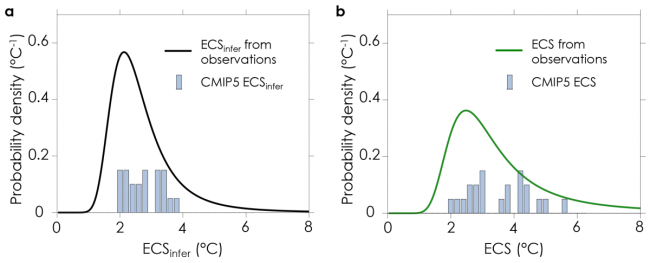Climate sensitivity in models consistent with energy budget constraints
Equilibrium climate sensitivity (ECS) — defined as the near-surface air temperature change that would eventually result from a doubling of atmospheric CO2 — is a key metric of climate change. A value of climate sensitivity can be inferred (ECSinfer) from global energy constraints using estimates of global surface warming, radiative forcing, and ocean heat content changes since the pre-industrial era. These energy budget constraints suggest a value of ECSinfer around 2°C, which is lower than the values of ECS suggested by other estimates, such as from paleoclimate reconstructions, process-based observational analyses (e.g., emergent constraints), and global climate model simulations. This has led to the suggestion that climate models may be too sensitive to greenhouse gas forcing, thus potentially predicting too much future warming.

A key, but often unstated, assumption of such energy budget constraints is that the same climate sensitivity inferred today also applies to the distant future. That is, ECS is generally assumed to be approximately equal to the value of ECSinfer. However, global climate models robustly show that feedbacks vary over time, with a strong tendency for climate sensitivity to increase as equilibrium is approached, resulting in values of ECSinfer under transient warming that are smaller than ECS. The reason for this behavior is that the Southern Ocean and east tropical Pacific Ocean are slow to warm relative to the rest of the world oceans; when these regions eventually do warm, positive radiative feedbacks become activated, increasing the sensitivity of climate to greenhouse gas forcing.
This paper shows that the long-term value of ECS is, on average, 26% above values of ECSinfer during transient warming within the suite of CMIP5 global climate models, with a larger discrepancy when climate sensitivity is high. Moreover, CMIP5 values of ECSinfer — inferred in a way that is analogous to how observations are used — are found to be consistent with energy budget constraints on ECSinfer (within the 90% confidence range) (Figure a). This suggests that the models are not overly sensitive. Yet, interestingly, they do tend to have values of ECSinfer above the median energy budget estimate.
Finally, using model-based estimates of how climate feedbacks will change in the future, in conjunction with recent energy budget constraints, produces an estimate of ECS that accounts for the inconstancy of climate feedbacks. This method gives a current best estimate of ECS of 2.9°C (1.7–7.1°C, 90% confidence) (Figure b). The findings suggest that the value of ECS estimated from global energy budget constraints is actually in agreement with values derived from other methods and simulated by global climate models.
Energy budget constraints on climate sensitivity in light of inconstant climate feedback (Nature Climate Change)
University of Washington
Topics
- Modeling
- Climate Change
